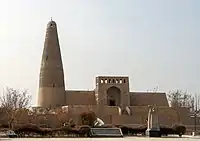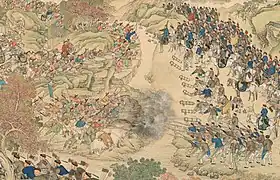Emin Khoja
Emin Khoja, also Amīn Khoja, Emin Khwaja, was a Uighur leader from Turfan who revolted against the Mongol Buddhist Dzungar Khanate in 1720, while the Dzungars under Tsewang Rabtan were being attacked by the Qing dynasty in the Dzungar–Qing Wars. Emin Khoja also submitted to the Qing.[1] Uighur Muslims like Emin Khoja from Turfan revolted against their Dzungar Buddhist rulers and pledged allegiance to Qing China to deliver them from Dzungar Buddhist rule. The Qing eventually eliminated the Dzungars in the Dzungar genocide. Emin Khoja was "arguably the most prominent Muslim collaborator in the Qing imperial expansion into Central Asia".[2]

Emin Khoja collaborated with the Qing against the Dzungar from 1755, contributing 300 soldiers to the Qing campaign against the Dzungars in the Ili region.[3]
Emin Khoja also allied with the Qing to crush the Revolt of the Altishahr Khojas led by Burhan-ud-din and Khan Khoja, and drove them to Badakhshan. The Qing armies reached far in Central Asia and came to the outskirts of Tashkent while the Kazakh rulers made their submissions as vassals to the Qing.[4]
Emin Khoja received the official nobiliary Chinese title of Fuguo gong (辅国公, "Duke Who Assists to the State").[5] He was left as semi-autonomous ruler of Turpan and later appointed as ruler of Yarkand in the newly created province of Nan-lu (Southern Road) in 1760.
The Emin Minaret was built by his son and successor Suleiman in 1777 in the memory of his father. It is the tallest minaret in China.
 Minaret of Turpan ruler Emin Khoja, built by his son and successor Suleiman in 1777 in the memory of his father (tallest minaret in China)
Minaret of Turpan ruler Emin Khoja, built by his son and successor Suleiman in 1777 in the memory of his father (tallest minaret in China) Emin Minaret
Emin Minaret Emin Khoja fought alongside the Qing (right) in the repression of the Revolt of the Altishahr Khojas
Emin Khoja fought alongside the Qing (right) in the repression of the Revolt of the Altishahr Khojas
References
- Dani, Ahmad Hasan; Masson, Vadim Mikhaĭlovich; Unesco (2003-01-01). History of Civilizations of Central Asia: Development in contrast : from the sixteenth to the mid-nineteenth century. UNESCO. ISBN 978-92-3-103876-1.
- KIM, KWANGMIN (2012). "Profit and Protection: Emin Khwaja and the Qing Conquest of Central Asia, 1759—1777". The Journal of Asian Studies. 71 (3): 604. ISSN 0021-9118.
- Dani, Ahmad Hasan; Masson, Vadim Mikhaĭlovich (1 January 2003). History of Civilizations of Central Asia: Development in contrast : from the sixteenth to the mid-nineteenth century. UNESCO. ISBN 978-92-3-103876-1.
- Newby, L. J. (2005). The Empire And the Khanate: A Political History of Qing Relations With Khoqand C1760-1860. BRILL. ISBN 978-90-04-14550-4.
- KIM, KWANGMIN (2012). "Profit and Protection: Emin Khwaja and the Qing Conquest of Central Asia, 1759—1777". The Journal of Asian Studies. 71 (3): 603. ISSN 0021-9118.